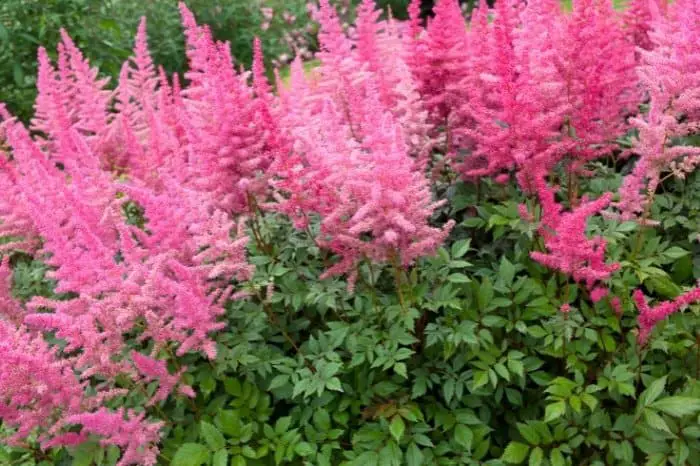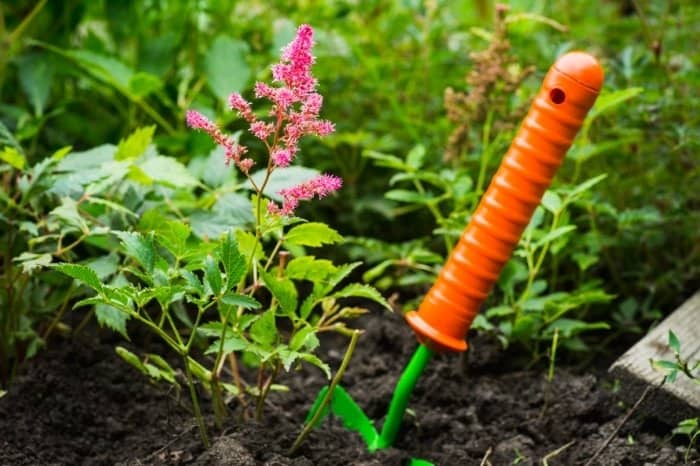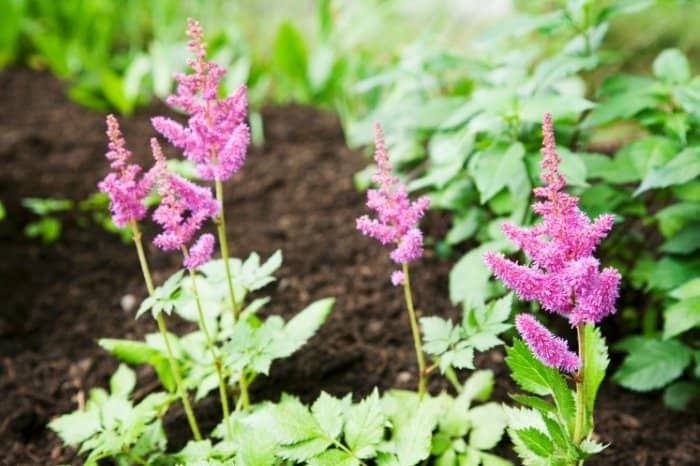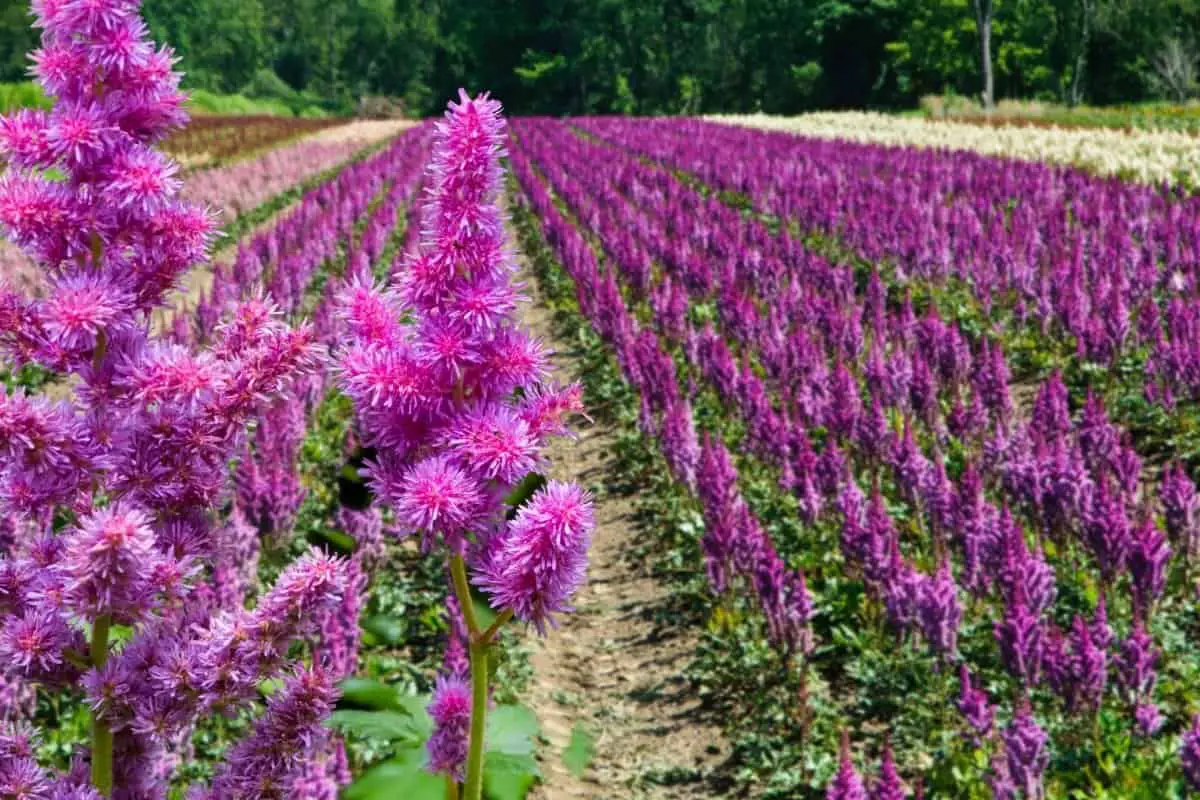Last Updated on February 3, 2022 by
When to plant astilbe? Astilbes are versatile perennial flowers blooming from early summer to the fall. These plants have long blooming plume-like flowers in stunning colors ranging from pink, red, deep burgundy to white. The flowers have tall, stiff stalks and grow above the foliage.
Astilbe plants are hardy plants, easy to grow with low maintenance, and range from 1 to 4 feet tall. They light up your garden and your home with their blooms.
The Astilbe genus contains at least 18 perennial species. These flowers have hundreds of cultivars to choose from, giving gardeners a wide range of options. They are North America and Asia. The most common ones are cultivars of Chinese astilbe (Astilbe Chinensis) or a hybrid known as A. x arendsii created by crossing A. thunbergii, A. Chinensis, and A. astilboides.
Quick Facts About Astilbe
- They are hardy plants, easy-to-grow, and strong perennials.
- Astilbe requires damp soil in shade or sun.
- They flower starting July to October.
- Their faded plumes look attractive all through winter.
- They attain a height of 1 to 4 feet tall.
- You can divide their clumps for replanting every 4 years.
- They are Ideal for natural pond edges, bog gardens, and streamsides.

When To Plant Astilbe
Astilbe is best planted in spring or fall. Avoid planting it in the summer due to the hot weather that tends to dry it out. If you must plant in the summer, keep the plant well-watered until you begin to see new growth emerging.
You can start it from seed, but it may not germinate and takes a few years to get a substantial plant. The best will be using divided mature clumps to regrow new plants.
When you plant them in the spring or fall, you can expect blooms from these flowers to arrive early summer through fall.
Astilbe is a slow-growing plant; however, once established, they bloom for many years before replanting.
Where To Plant Astilbe
Astilbes grow well in moist, well-drained soils with slightly low moisture. Do not grow these flowers on waterlogged soils. Amend clay soil or soils that don’t drain well with peat moss, perlite, and coarse sand to improve drainage.
They prefer a shady area allowing their bloom to brighten the area around them with color and texture.
The full sun tends to burn these beauties, which is why you should plant them in light to moderate shade. They do well where many other flowers won’t survive.
How To Grow Astilbe
It is easy to grow these flowers; however, you need to know the right place and conditions to grow them.
Location
Astilbes thrive in partial shade; they can stand the morning sun but burn in the full or afternoon sun. It is more difficult for them to survive in warmer regions if planted under direct sun. Choose a sheltered spot in your yard to plant these flowers.
Now that we have talked about a shady area don’t plant them under trees. Trees will compete with these flowers for moisture and nutrients.
Plant astilbe away from shrubs and trees so that they don’t have to compete for water with other larger plants.
Soil
These plants love rich, moist, well-drained soils. These plants do not thrive on waterlogged soils. You will have to include peat moss, perlite, and coarse sand for clay soils to improve drainage.
Planting Clumps
Dig holes that are 1 to 2 inches deep, enough for the plant’s crown to be under the soil. You can buy bare-root plants; they usually come in bags wrapped in peat moss rather than in pots.
These root plants tend to dry out; that’s why it’s important to soak the roots in 24 hours to rehydrate them before planting.

You can also buy your astilbe plants from nurseries around you either in the spring or fall.
Plant your astilbe plants at least 1 – 3 feet apart. The clumps will soon expand and gradually grow together. Divide your clumps every 3 – 4 years for more of their bloom in the following years.
Watering
Astilbe requires 1-2 inches of water every week. If they don’t get ample water, the leaves begin to turn brown. If you leave these plants without water for too long, they die.
When you are encountering a long dry spell of weather, keep these flowers well-watered. They are moisture-loving plants but don’t confuse this with water-logging. They will not forgive you if you give them too much water.
Fertilizing
If you like, apply a balanced fertilizer like the 10-10-10 in the fall. Apply this fertilizer after the after finish blooming.
Astilbes are heavy feeders meaning they will use lots of nutrients. You will need to feed the soil every year with more nutrients to keep these plants growing healthy.
Southern Ag All Purpose Granular Fertilizer 10-10-10, 5 LB
During the fall, Astilbe foliage dies after the first frost. Please do not cut it down; it’s best to leave it to protect the plant’s crown during the cold winter weather. Once winter is over, you can cut back the dead foliage in the early spring after the last frost.
If You Are Looking for Beautiful Flowers, click here:
How To Divide Astilbe
Every 3 to 4 years, it’s time to divide your plant’s roots. Dividing prevents them from becoming overcrowded.
When Astilbe plants become overcrowded, they stop growing and do not flower well. Overcrowding also makes the plants weak, leaving them susceptible to disease and insect infestations.
You can divide your Astilbe clumps in the spring or fall, with spring being the best. Use a garden fork to lift the rhizomes from the soil delicately and a sharp knife or pruners to cut into 12-inch sections. Any diseased or dead rhizomes should be discarded.
Replant the new plants in a shady spot at least 1 to 3 feet apart. Ensure to plant them at the same depth as they were original, with the plant’s crown at least 1 to 2 inches deep.

Conclusion
Astilbes are beautiful flowers to add to your flower collections and enjoy their pink, red, white, or burgundy colored blooms.
These are easy to grow and maintain, making it easy for any gardener to grow them. They will come back year after year, blooming very beautifully around your garden. Why not grow these blooming beauties.
FAQs
When should I plant astilbe?
Planting Astilbe in late spring is the best time to grow it in a large container. It's not going to survive the cold, wet winter and then come back next year. The spring temperatures are too hot and the rain will be a problem as well. Late summer or fall is fine for planting it in a pot. Astilbe flowers best in full sun.
It needs a good amount of moisture, but not too much water. A lot of rain can kill it. Astilbe is very easy to grow, but if you do get any whiteflies or aphids on it, spray with an insecticidal soap. There are many different cultivars available; some are more tolerant to certain insects than others.
Can I plant astilbe in the fall?
Yes, you can. Astilbes are hardy and will survive the winter. In fact, some varieties will produce new leaves in the spring. Astilbes are also among the first plants to flower in the spring.
Where can I plant it to make sure it flowers?
You can plant it anywhere in your garden, but it will flower best if you plant it in a sunny location with well-drained soil. The blooms are pretty but not as large as some of the other flowers.
Do astilbe come back every year?
Astilbe is a perennial. It is grown as an annual in colder regions and as a perennial in warmer climates.
How long does it take astilbe to grow?
It takes about a year. It is an easy plant to grow, but it can become invasive.
For a typical garden, astilbe should be planted after the last frost and then given at least four weeks of good moisture before planting out. It grows best in full sun, but can tolerate light shade and is quite hardy, needing only a minimum amount of water.
What can I plant next to astilbe?
I think the answer depends on where you live. For instance, I'm pretty sure the answer is different in the Pacific Northwest than in the Rocky Mountains.
If you want to find out what is good for your area, the best thing to do is to ask someone who knows. In the Rockies, we recommend planting Astilbes with other plants because they like cooler temperatures and need to be planted in a shady spot. You can also add Astilbe to your landscape as an accent plant, especially if you have ever wanted to use Astilbe in the garden.
What happens if it isn't well watered?
The plant is prone to crown rot if not kept well watered.
Caroline is a gardener who loves to get down to the nitty–gritty of gardening. She proudly proclaims herself as a ‘dirt worshipper‘ and can often be found deep in the garden, covered in soil and singing to her plants. As a self–proclaimed ‘plant whisperer‘, Caroline believes that plants need love and attention just like any other living thing, and she loves to give them both. When she‘s not tending to her garden, you can often find her researching the latest gardening trends, or teaching others how to make their gardens thrive


